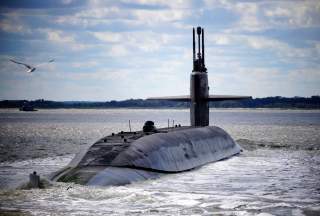Could Russia's Sonor-Wielding Drones Unmask the Navy's Submarines?
Submarines' life of hide and seek just got more complicated.
Key point: Every great power is rushing to get in on the drone ship and sub game.
Russia is working on a new trick to track American submarines: sonar-equipped robots.
But turnabout is fair play: the United States has already developed a robotic yacht-sized surface craft designed to stalk diesel subs.
Russia has begun testing unmanned underwater vehicles (UUVs) equipped with towed sonar arrays, according to the newspaper Izvestia. Attached to long, flexible tethers more than a mile long, towed sonar transmitters and receivers are far enough from the noise of the towing surface ship that they suffer less interference. The downside is that like a car towing a U-Haul trailer, the towing ship moves more slowly and has to maneuver more carefully to avoid snapping the tether.
“During maneuvers, the antenna is bent, which means that the signal is lost or distorted,” Izvestia explained. “Also, the long ‘tails’ of antennas seriously limit the maneuvers and speed of ships, preventing them from attacking.”
So why not attack the sonar and tether to a remote-controlled underwater robot that can operate detached from the mother ship, which can enjoy the advantages of a towed array without being hampered by it?
“Externally, the towing robot resembles a small submarine with a keel and several depth rudders,” Russian Navy officials told Izvestia. “It is located at the end of the antenna and adjusts the depth of its immersion, as well as if necessary, taxiing during the maneuvers of the ship.”
Naval expert Alexander Mozgovoy told Izvestia that the Russian Navy has long wanted to make towed sonar arrays less awkward. “The advantage of the towed antenna is high sensitivity, especially in the passive mode, because due to the considerable length it is less affected by noise and vibration from the power plant of the carrier ship itself. Previously, there were special ships, a kind of hydroacoustic AWACS [Airborne Warning and Control System], with huge towed antennas. They were intended to search for atomic submarines and to target aviation and anti-submarine forces on them. But because of the large size, towed antennas can be used only in the open sea, and better in the ocean, where there is enough depth and there is room for maneuver. Therefore, anti-submarine ships often work in pairs or groups: one tracks the underwater environment, while others attack detected targets.”
Russian warships equipped with towed arrays can detect a moving submarine at a distance of 9.3 to 12.4 miles, a surface ship at a distance of 30 to 100 kilometers (18.6 to 62.1 miles) and an incoming torpedo at 15 to 30 kilometers (9.3 to 18.6 miles), according to Izvestia.
Meanwhile, towed sensors have also been tested on the U.S. Navy’s Sea Hunter (formerly DARPA’s ACTUV project), a 130-foot-long robot surface ship designed to autonomously patrol the oceans in search of quiet diesel submarines. But for Sea Hunter, it was more like parasailing as a sensor-equipped glider was tethered a thousand feet above the ship.
The U.S. Navy has been interested in robot-towed sonars since at least 2005, and Boeing and Lockheed Martin are developing designs for the Orca Extra Large Unmanned Underwater Vehicle (XLUUV), essentially an unmanned diesel submarine.
For now, submarines are the most stealthy of military craft, lurking deep and silent in the vast depths of the ocean. But on the horizon is a future where the oceans are blanketed by multitudes of sonar-towing underwater robots, which are cheap compared to manned ships and aircraft, and expendable as well.
Michael Peck is a contributing writer for the National Interest. He can be found on Twitter and Facebook. This first appeared in November 2018.
Image: Reuters.

